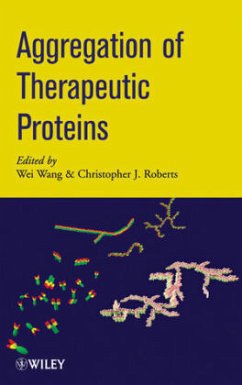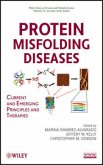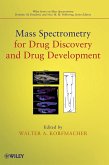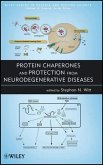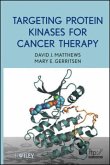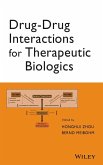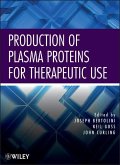Aggregation of Therapeutic Proteins
Herausgegeben von Wang, Wei; Roberts, Christopher J.
Aggregation of Therapeutic Proteins
Herausgegeben von Wang, Wei; Roberts, Christopher J.
- Gebundenes Buch
- Merkliste
- Auf die Merkliste
- Bewerten Bewerten
- Teilen
- Produkt teilen
- Produkterinnerung
- Produkterinnerung
This book gives pharmaceutical scientists an up-to-date resource on protein aggregation and its consequences, and available methods to control or slow down the aggregation process. While significant progress has been made in the past decade, the current understanding of protein aggregation and its consequences is still immature. Prevention or even moderate inhibition of protein aggregation has been mostly experimental. The knowledge in this book can greatly help pharmaceutical scientists in the development of therapeutic proteins, and also instigate further scientific investigations in this…mehr
Andere Kunden interessierten sich auch für
![Protein Misfolding Diseases Protein Misfolding Diseases]() Jeffery W. KellyProtein Misfolding Diseases285,99 €
Jeffery W. KellyProtein Misfolding Diseases285,99 €![Mass Spectrometry for Drug Discovery and Drug Development Mass Spectrometry for Drug Discovery and Drug Development]() Mass Spectrometry for Drug Discovery and Drug Development158,99 €
Mass Spectrometry for Drug Discovery and Drug Development158,99 €![Gpcrs as Therapeutic Targets Gpcrs as Therapeutic Targets]() Gpcrs as Therapeutic Targets423,99 €
Gpcrs as Therapeutic Targets423,99 €![Protein Chaperones and Protection from Neurodegenerative Diseases Protein Chaperones and Protection from Neurodegenerative Diseases]() Protein Chaperones and Protection from Neurodegenerative Diseases191,99 €
Protein Chaperones and Protection from Neurodegenerative Diseases191,99 €![Targeting Protein Kinases for Cancer Therapy Targeting Protein Kinases for Cancer Therapy]() David J. MatthewsTargeting Protein Kinases for Cancer Therapy195,99 €
David J. MatthewsTargeting Protein Kinases for Cancer Therapy195,99 €![Drug-Drug Interactions for Therapeutic Biologics Drug-Drug Interactions for Therapeutic Biologics]() Honghui ZhouDrug-Drug Interactions for Therapeutic Biologics159,99 €
Honghui ZhouDrug-Drug Interactions for Therapeutic Biologics159,99 €![Production of Plasma Proteins for Therapeutic Use Production of Plasma Proteins for Therapeutic Use]() Joseph BertoliniProduction of Plasma Proteins for Therapeutic Use192,99 €
Joseph BertoliniProduction of Plasma Proteins for Therapeutic Use192,99 €-
-
-
This book gives pharmaceutical scientists an up-to-date resource on protein aggregation and its consequences, and available methods to control or slow down the aggregation process. While significant progress has been made in the past decade, the current understanding of protein aggregation and its consequences is still immature. Prevention or even moderate inhibition of protein aggregation has been mostly experimental. The knowledge in this book can greatly help pharmaceutical scientists in the development of therapeutic proteins, and also instigate further scientific investigations in this area. This book fills such a need by providing an overview on the causes, consequences, characterization, and control of the aggregation of therapeutic proteins.
Hinweis: Dieser Artikel kann nur an eine deutsche Lieferadresse ausgeliefert werden.
Hinweis: Dieser Artikel kann nur an eine deutsche Lieferadresse ausgeliefert werden.
Produktdetails
- Produktdetails
- Verlag: Wiley & Sons
- 1. Auflage
- Seitenzahl: 516
- Erscheinungstermin: 30. August 2010
- Englisch
- Abmessung: 251mm x 167mm x 30mm
- Gewicht: 826g
- ISBN-13: 9780470411964
- ISBN-10: 0470411961
- Artikelnr.: 29931233
- Herstellerkennzeichnung
- Libri GmbH
- Europaallee 1
- 36244 Bad Hersfeld
- gpsr@libri.de
- Verlag: Wiley & Sons
- 1. Auflage
- Seitenzahl: 516
- Erscheinungstermin: 30. August 2010
- Englisch
- Abmessung: 251mm x 167mm x 30mm
- Gewicht: 826g
- ISBN-13: 9780470411964
- ISBN-10: 0470411961
- Artikelnr.: 29931233
- Herstellerkennzeichnung
- Libri GmbH
- Europaallee 1
- 36244 Bad Hersfeld
- gpsr@libri.de
WEI WANG, PhD, is a Research Fellow at Pfizer Global Biologics. He is also Adjunct Professor in the School of Pharmacy and Health at the University of the Pacific in California and Guest Professor at Shandong University in China. CHRISTOPHER J. ROBERTS, PhD, is Associate Professor of Chemical Engineering at the University of Delaware. Previously, he was a senior research scientist in pharmaceutical R & D at Pfizer.
Preface xvii
Contributors xxi
1. Fundamental Structures and Behaviors of Proteins 1
Jennifer S. Laurence and C. Russell Middaugh
1.1 The Problem of Protein Aggregation 1
1.2 Parallels to Protein Folding 11
1.3 Views of Protein Stability and Aggregation 12
1.4 Models of Aggregation 22
1.5 Models of Protein Folding 29
1.6 Influences of Chemical Alteration on Aggregation 40
1.7 Approaches to Predicting Aggregation 46
1.8 Conclusions 49
References 50
2. Protein Aggregation Pathways, Kinetics, and Thermodynamics 63
Yi Li and Christopher J. Roberts
2.1 Introduction 63
2.2 Native and Nonnative Aggregation Pathways 66
2.3 Thermodynamics of Reversible Self-Association 69
2.4 Aggregation Kinetics and Distinguishing Kinetic Pathways 75
2.5 Chemical Modifications 80
2.6 Effects of Cosolvents or Cosolutes 82
Appendix-Derivation of ?t32 for van der Waals (vdW) Mixture 94
Acknowledgments 97
References 97
3. Identification and Impact of Aggregation-Prone Regions in Proteins and
Therapeutic Monoclonal Antibodies 103
Sandeep Kumar, Xiaoling Wang, and Satish K. Singh
3.1 Introduction 103
3.2 Energy Landscapes, Protein Folding, and Aggregation 105
3.3 Prediction of APRs in Proteins and Biotherapeutics 106
3.4 Conclusions and Future Directions 114
Acknowledgments 115
References 115
4. External Factors Affecting Protein Aggregation 119
Wei Wang, Ning Li, and Stan Speaker
4.1 Introduction 119
4.2 Protein Aggregation Pathways 120
4.3 Effects of Temperature 132
4.4 Effects of Solution Conditions and Composition on Protein Aggregation
136
4.5 Effects of Processing Steps on Protein Aggregation 164
4.6 Effects of Solid-State Condition and Composition on Protein Aggregation
174
4.7 Summary 177
Acknowledgment 178
References 178
5. Experimental Detection and Characterization of Protein Aggregates 205
Vikas K. Sharma and Devendra S. Kalonia
5.1 Introduction 205
5.2 Aggregate Classifi cation 206
5.3 Analytical Tools for the Characterization of Aggregates 212
5.4 Summary 246
References 247
6. Approaches to Control Protein Aggregation during Bulk Production 257
Linda O. Narhi, Yijia Jiang, Rohini Deshpande, Sohye Kang, and Joseph
Shultz
6.1 Introduction 257
6.2 Candidate Selection 257
6.3 Protein Aggregation and Cell Culture 269
6.4 Protein Aggregation and Purifi cation 271
6.5 Summary 295
References 295
7. Protein Aggregation and Particle Formation: Effects of Formulation,
Interfaces, and Drug Product Manufacturing Operations 301
Hanns-Christian Mahler, Stefan Fischer, Theodore W. Randolph, and John F.
Carpenter
7.1 Introduction 301
7.2 Roles of Conformational and Colloidal Stability in Reducing Rates of
Aggregation 302
7.3 Effects of Interfaces on Protein Aggregation 305
7.4 Critical Processing Steps during Drug Product Manufacturing of
Biopharmaceuticals 310
7.5 Particles in Parenteral Products and Visible Inspection 316
7.6 Summary and Outlook 324
References 325
8. Approaches to Managing Protein Aggregation in Product Development 333
Wei Wang and Nicholas W. Warne
8.1 Introduction 333
8.2 Approaches in Formulation Development 334
8.3 Protection of Proteins in Various Processing Steps 345
8.4 Aggregation Control by Structural Modifi cations 351
8.5 Summary 353
References 354
9. Case Studies Involving Protein Aggregation 367
Rahul S. Rajan, Tiansheng Li, and Tsutomu Arakawa
9.1 Introduction 367
9.2 Case Study 1: Aggregation in the Liquid State: The Role of Osmolytes in
Stabilizing KGF toward Aggregation 368
9.3 Case Study 2: Aggregation in the Liquid State: Heterogeneity and
Non-Linearity in IgG2 Aggregation
during Long-Term Storage 376
9.4 Case Study 3: Aggregation in the Frozen State: The Role of Excipient
Crystallization 381
9.5 Case Studies 4 and 5: Aggregation in the Lyophilized State: Role of
Residual Moisture and Mechanisms
of Excipient Stabilization 385
9.6 Case Study 6: Protein Particulation Due to Nucleation by Foreign
Material in Fill/Finish Manufacturing Operations 391
9.7 Overall Discussion 394
Acknowledgments 396
References 396
10. Aggregation and Immunogenicity of Therapeutic Proteins 403
Vasco Filipe, Andrea Hawe, Huub Schellekens, and Wim Jiskoot
10.1 Introduction 403
10.2 Immunogenicity of Therapeutic Proteins 404
10.3 Immune Mechanisms Related to Protein Immunogenicity 409
10.4 Aggregates and Immunogenicity 415
10.5 Conclusions 427
References 428
11. Regulatory Perspective on Aggregates as a Product Quality Attribute 435
Wendy C. Weinberg, Linan Ha, Susan L. Kirshner, and Daniela I. Verthelyi
11.1 Introduction 435
11.2 An Overview of the Regulatory Process 436
11.3 Product Aggregates and Safety Concerns 438
11.4 The Assessment of Aggregates: Regulatory Approaches to Controlling
Product Aggregation 440
11.5 Future Challenges 446
11.6 Summary 447
Acknowledgments 447
Disclaimer 447
References 448
Index 453
Contributors xxi
1. Fundamental Structures and Behaviors of Proteins 1
Jennifer S. Laurence and C. Russell Middaugh
1.1 The Problem of Protein Aggregation 1
1.2 Parallels to Protein Folding 11
1.3 Views of Protein Stability and Aggregation 12
1.4 Models of Aggregation 22
1.5 Models of Protein Folding 29
1.6 Influences of Chemical Alteration on Aggregation 40
1.7 Approaches to Predicting Aggregation 46
1.8 Conclusions 49
References 50
2. Protein Aggregation Pathways, Kinetics, and Thermodynamics 63
Yi Li and Christopher J. Roberts
2.1 Introduction 63
2.2 Native and Nonnative Aggregation Pathways 66
2.3 Thermodynamics of Reversible Self-Association 69
2.4 Aggregation Kinetics and Distinguishing Kinetic Pathways 75
2.5 Chemical Modifications 80
2.6 Effects of Cosolvents or Cosolutes 82
Appendix-Derivation of ?t32 for van der Waals (vdW) Mixture 94
Acknowledgments 97
References 97
3. Identification and Impact of Aggregation-Prone Regions in Proteins and
Therapeutic Monoclonal Antibodies 103
Sandeep Kumar, Xiaoling Wang, and Satish K. Singh
3.1 Introduction 103
3.2 Energy Landscapes, Protein Folding, and Aggregation 105
3.3 Prediction of APRs in Proteins and Biotherapeutics 106
3.4 Conclusions and Future Directions 114
Acknowledgments 115
References 115
4. External Factors Affecting Protein Aggregation 119
Wei Wang, Ning Li, and Stan Speaker
4.1 Introduction 119
4.2 Protein Aggregation Pathways 120
4.3 Effects of Temperature 132
4.4 Effects of Solution Conditions and Composition on Protein Aggregation
136
4.5 Effects of Processing Steps on Protein Aggregation 164
4.6 Effects of Solid-State Condition and Composition on Protein Aggregation
174
4.7 Summary 177
Acknowledgment 178
References 178
5. Experimental Detection and Characterization of Protein Aggregates 205
Vikas K. Sharma and Devendra S. Kalonia
5.1 Introduction 205
5.2 Aggregate Classifi cation 206
5.3 Analytical Tools for the Characterization of Aggregates 212
5.4 Summary 246
References 247
6. Approaches to Control Protein Aggregation during Bulk Production 257
Linda O. Narhi, Yijia Jiang, Rohini Deshpande, Sohye Kang, and Joseph
Shultz
6.1 Introduction 257
6.2 Candidate Selection 257
6.3 Protein Aggregation and Cell Culture 269
6.4 Protein Aggregation and Purifi cation 271
6.5 Summary 295
References 295
7. Protein Aggregation and Particle Formation: Effects of Formulation,
Interfaces, and Drug Product Manufacturing Operations 301
Hanns-Christian Mahler, Stefan Fischer, Theodore W. Randolph, and John F.
Carpenter
7.1 Introduction 301
7.2 Roles of Conformational and Colloidal Stability in Reducing Rates of
Aggregation 302
7.3 Effects of Interfaces on Protein Aggregation 305
7.4 Critical Processing Steps during Drug Product Manufacturing of
Biopharmaceuticals 310
7.5 Particles in Parenteral Products and Visible Inspection 316
7.6 Summary and Outlook 324
References 325
8. Approaches to Managing Protein Aggregation in Product Development 333
Wei Wang and Nicholas W. Warne
8.1 Introduction 333
8.2 Approaches in Formulation Development 334
8.3 Protection of Proteins in Various Processing Steps 345
8.4 Aggregation Control by Structural Modifi cations 351
8.5 Summary 353
References 354
9. Case Studies Involving Protein Aggregation 367
Rahul S. Rajan, Tiansheng Li, and Tsutomu Arakawa
9.1 Introduction 367
9.2 Case Study 1: Aggregation in the Liquid State: The Role of Osmolytes in
Stabilizing KGF toward Aggregation 368
9.3 Case Study 2: Aggregation in the Liquid State: Heterogeneity and
Non-Linearity in IgG2 Aggregation
during Long-Term Storage 376
9.4 Case Study 3: Aggregation in the Frozen State: The Role of Excipient
Crystallization 381
9.5 Case Studies 4 and 5: Aggregation in the Lyophilized State: Role of
Residual Moisture and Mechanisms
of Excipient Stabilization 385
9.6 Case Study 6: Protein Particulation Due to Nucleation by Foreign
Material in Fill/Finish Manufacturing Operations 391
9.7 Overall Discussion 394
Acknowledgments 396
References 396
10. Aggregation and Immunogenicity of Therapeutic Proteins 403
Vasco Filipe, Andrea Hawe, Huub Schellekens, and Wim Jiskoot
10.1 Introduction 403
10.2 Immunogenicity of Therapeutic Proteins 404
10.3 Immune Mechanisms Related to Protein Immunogenicity 409
10.4 Aggregates and Immunogenicity 415
10.5 Conclusions 427
References 428
11. Regulatory Perspective on Aggregates as a Product Quality Attribute 435
Wendy C. Weinberg, Linan Ha, Susan L. Kirshner, and Daniela I. Verthelyi
11.1 Introduction 435
11.2 An Overview of the Regulatory Process 436
11.3 Product Aggregates and Safety Concerns 438
11.4 The Assessment of Aggregates: Regulatory Approaches to Controlling
Product Aggregation 440
11.5 Future Challenges 446
11.6 Summary 447
Acknowledgments 447
Disclaimer 447
References 448
Index 453
Preface xvii
Contributors xxi
1. Fundamental Structures and Behaviors of Proteins 1
Jennifer S. Laurence and C. Russell Middaugh
1.1 The Problem of Protein Aggregation 1
1.2 Parallels to Protein Folding 11
1.3 Views of Protein Stability and Aggregation 12
1.4 Models of Aggregation 22
1.5 Models of Protein Folding 29
1.6 Influences of Chemical Alteration on Aggregation 40
1.7 Approaches to Predicting Aggregation 46
1.8 Conclusions 49
References 50
2. Protein Aggregation Pathways, Kinetics, and Thermodynamics 63
Yi Li and Christopher J. Roberts
2.1 Introduction 63
2.2 Native and Nonnative Aggregation Pathways 66
2.3 Thermodynamics of Reversible Self-Association 69
2.4 Aggregation Kinetics and Distinguishing Kinetic Pathways 75
2.5 Chemical Modifications 80
2.6 Effects of Cosolvents or Cosolutes 82
Appendix-Derivation of ?t32 for van der Waals (vdW) Mixture 94
Acknowledgments 97
References 97
3. Identification and Impact of Aggregation-Prone Regions in Proteins and
Therapeutic Monoclonal Antibodies 103
Sandeep Kumar, Xiaoling Wang, and Satish K. Singh
3.1 Introduction 103
3.2 Energy Landscapes, Protein Folding, and Aggregation 105
3.3 Prediction of APRs in Proteins and Biotherapeutics 106
3.4 Conclusions and Future Directions 114
Acknowledgments 115
References 115
4. External Factors Affecting Protein Aggregation 119
Wei Wang, Ning Li, and Stan Speaker
4.1 Introduction 119
4.2 Protein Aggregation Pathways 120
4.3 Effects of Temperature 132
4.4 Effects of Solution Conditions and Composition on Protein Aggregation
136
4.5 Effects of Processing Steps on Protein Aggregation 164
4.6 Effects of Solid-State Condition and Composition on Protein Aggregation
174
4.7 Summary 177
Acknowledgment 178
References 178
5. Experimental Detection and Characterization of Protein Aggregates 205
Vikas K. Sharma and Devendra S. Kalonia
5.1 Introduction 205
5.2 Aggregate Classifi cation 206
5.3 Analytical Tools for the Characterization of Aggregates 212
5.4 Summary 246
References 247
6. Approaches to Control Protein Aggregation during Bulk Production 257
Linda O. Narhi, Yijia Jiang, Rohini Deshpande, Sohye Kang, and Joseph
Shultz
6.1 Introduction 257
6.2 Candidate Selection 257
6.3 Protein Aggregation and Cell Culture 269
6.4 Protein Aggregation and Purifi cation 271
6.5 Summary 295
References 295
7. Protein Aggregation and Particle Formation: Effects of Formulation,
Interfaces, and Drug Product Manufacturing Operations 301
Hanns-Christian Mahler, Stefan Fischer, Theodore W. Randolph, and John F.
Carpenter
7.1 Introduction 301
7.2 Roles of Conformational and Colloidal Stability in Reducing Rates of
Aggregation 302
7.3 Effects of Interfaces on Protein Aggregation 305
7.4 Critical Processing Steps during Drug Product Manufacturing of
Biopharmaceuticals 310
7.5 Particles in Parenteral Products and Visible Inspection 316
7.6 Summary and Outlook 324
References 325
8. Approaches to Managing Protein Aggregation in Product Development 333
Wei Wang and Nicholas W. Warne
8.1 Introduction 333
8.2 Approaches in Formulation Development 334
8.3 Protection of Proteins in Various Processing Steps 345
8.4 Aggregation Control by Structural Modifi cations 351
8.5 Summary 353
References 354
9. Case Studies Involving Protein Aggregation 367
Rahul S. Rajan, Tiansheng Li, and Tsutomu Arakawa
9.1 Introduction 367
9.2 Case Study 1: Aggregation in the Liquid State: The Role of Osmolytes in
Stabilizing KGF toward Aggregation 368
9.3 Case Study 2: Aggregation in the Liquid State: Heterogeneity and
Non-Linearity in IgG2 Aggregation
during Long-Term Storage 376
9.4 Case Study 3: Aggregation in the Frozen State: The Role of Excipient
Crystallization 381
9.5 Case Studies 4 and 5: Aggregation in the Lyophilized State: Role of
Residual Moisture and Mechanisms
of Excipient Stabilization 385
9.6 Case Study 6: Protein Particulation Due to Nucleation by Foreign
Material in Fill/Finish Manufacturing Operations 391
9.7 Overall Discussion 394
Acknowledgments 396
References 396
10. Aggregation and Immunogenicity of Therapeutic Proteins 403
Vasco Filipe, Andrea Hawe, Huub Schellekens, and Wim Jiskoot
10.1 Introduction 403
10.2 Immunogenicity of Therapeutic Proteins 404
10.3 Immune Mechanisms Related to Protein Immunogenicity 409
10.4 Aggregates and Immunogenicity 415
10.5 Conclusions 427
References 428
11. Regulatory Perspective on Aggregates as a Product Quality Attribute 435
Wendy C. Weinberg, Linan Ha, Susan L. Kirshner, and Daniela I. Verthelyi
11.1 Introduction 435
11.2 An Overview of the Regulatory Process 436
11.3 Product Aggregates and Safety Concerns 438
11.4 The Assessment of Aggregates: Regulatory Approaches to Controlling
Product Aggregation 440
11.5 Future Challenges 446
11.6 Summary 447
Acknowledgments 447
Disclaimer 447
References 448
Index 453
Contributors xxi
1. Fundamental Structures and Behaviors of Proteins 1
Jennifer S. Laurence and C. Russell Middaugh
1.1 The Problem of Protein Aggregation 1
1.2 Parallels to Protein Folding 11
1.3 Views of Protein Stability and Aggregation 12
1.4 Models of Aggregation 22
1.5 Models of Protein Folding 29
1.6 Influences of Chemical Alteration on Aggregation 40
1.7 Approaches to Predicting Aggregation 46
1.8 Conclusions 49
References 50
2. Protein Aggregation Pathways, Kinetics, and Thermodynamics 63
Yi Li and Christopher J. Roberts
2.1 Introduction 63
2.2 Native and Nonnative Aggregation Pathways 66
2.3 Thermodynamics of Reversible Self-Association 69
2.4 Aggregation Kinetics and Distinguishing Kinetic Pathways 75
2.5 Chemical Modifications 80
2.6 Effects of Cosolvents or Cosolutes 82
Appendix-Derivation of ?t32 for van der Waals (vdW) Mixture 94
Acknowledgments 97
References 97
3. Identification and Impact of Aggregation-Prone Regions in Proteins and
Therapeutic Monoclonal Antibodies 103
Sandeep Kumar, Xiaoling Wang, and Satish K. Singh
3.1 Introduction 103
3.2 Energy Landscapes, Protein Folding, and Aggregation 105
3.3 Prediction of APRs in Proteins and Biotherapeutics 106
3.4 Conclusions and Future Directions 114
Acknowledgments 115
References 115
4. External Factors Affecting Protein Aggregation 119
Wei Wang, Ning Li, and Stan Speaker
4.1 Introduction 119
4.2 Protein Aggregation Pathways 120
4.3 Effects of Temperature 132
4.4 Effects of Solution Conditions and Composition on Protein Aggregation
136
4.5 Effects of Processing Steps on Protein Aggregation 164
4.6 Effects of Solid-State Condition and Composition on Protein Aggregation
174
4.7 Summary 177
Acknowledgment 178
References 178
5. Experimental Detection and Characterization of Protein Aggregates 205
Vikas K. Sharma and Devendra S. Kalonia
5.1 Introduction 205
5.2 Aggregate Classifi cation 206
5.3 Analytical Tools for the Characterization of Aggregates 212
5.4 Summary 246
References 247
6. Approaches to Control Protein Aggregation during Bulk Production 257
Linda O. Narhi, Yijia Jiang, Rohini Deshpande, Sohye Kang, and Joseph
Shultz
6.1 Introduction 257
6.2 Candidate Selection 257
6.3 Protein Aggregation and Cell Culture 269
6.4 Protein Aggregation and Purifi cation 271
6.5 Summary 295
References 295
7. Protein Aggregation and Particle Formation: Effects of Formulation,
Interfaces, and Drug Product Manufacturing Operations 301
Hanns-Christian Mahler, Stefan Fischer, Theodore W. Randolph, and John F.
Carpenter
7.1 Introduction 301
7.2 Roles of Conformational and Colloidal Stability in Reducing Rates of
Aggregation 302
7.3 Effects of Interfaces on Protein Aggregation 305
7.4 Critical Processing Steps during Drug Product Manufacturing of
Biopharmaceuticals 310
7.5 Particles in Parenteral Products and Visible Inspection 316
7.6 Summary and Outlook 324
References 325
8. Approaches to Managing Protein Aggregation in Product Development 333
Wei Wang and Nicholas W. Warne
8.1 Introduction 333
8.2 Approaches in Formulation Development 334
8.3 Protection of Proteins in Various Processing Steps 345
8.4 Aggregation Control by Structural Modifi cations 351
8.5 Summary 353
References 354
9. Case Studies Involving Protein Aggregation 367
Rahul S. Rajan, Tiansheng Li, and Tsutomu Arakawa
9.1 Introduction 367
9.2 Case Study 1: Aggregation in the Liquid State: The Role of Osmolytes in
Stabilizing KGF toward Aggregation 368
9.3 Case Study 2: Aggregation in the Liquid State: Heterogeneity and
Non-Linearity in IgG2 Aggregation
during Long-Term Storage 376
9.4 Case Study 3: Aggregation in the Frozen State: The Role of Excipient
Crystallization 381
9.5 Case Studies 4 and 5: Aggregation in the Lyophilized State: Role of
Residual Moisture and Mechanisms
of Excipient Stabilization 385
9.6 Case Study 6: Protein Particulation Due to Nucleation by Foreign
Material in Fill/Finish Manufacturing Operations 391
9.7 Overall Discussion 394
Acknowledgments 396
References 396
10. Aggregation and Immunogenicity of Therapeutic Proteins 403
Vasco Filipe, Andrea Hawe, Huub Schellekens, and Wim Jiskoot
10.1 Introduction 403
10.2 Immunogenicity of Therapeutic Proteins 404
10.3 Immune Mechanisms Related to Protein Immunogenicity 409
10.4 Aggregates and Immunogenicity 415
10.5 Conclusions 427
References 428
11. Regulatory Perspective on Aggregates as a Product Quality Attribute 435
Wendy C. Weinberg, Linan Ha, Susan L. Kirshner, and Daniela I. Verthelyi
11.1 Introduction 435
11.2 An Overview of the Regulatory Process 436
11.3 Product Aggregates and Safety Concerns 438
11.4 The Assessment of Aggregates: Regulatory Approaches to Controlling
Product Aggregation 440
11.5 Future Challenges 446
11.6 Summary 447
Acknowledgments 447
Disclaimer 447
References 448
Index 453

